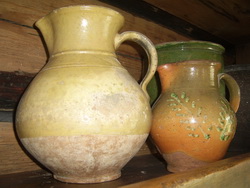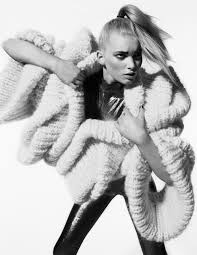Historic object
I am doing my historical object research on clay pot from Latvia. The colours tones and mix inspires me because the colours are very organic and rich. The patterns on pots are simple but interesting and it’s interesting to study the different symbols on the pots because later on I can make them in to patterns and bring them in to my knitted patterns, printed textiles or just painted patterns e.t.c.. The colours and the symbols reminds me of Latvia and I think the Latvians clay milk jugs is really good way how to represent Latvia and even the different parts of Latvia.

Neolithic pottery : Comb Ceramic culture ( 3400th – 2300th g. Pr. Kr. ) Pots. Photographer Baiba Dumpe, Latvia
In the Latvia crafts as pottery existed since the 10th century. The first pottery’s wheel was brought in to the Riga, capital of Latvia. The first pot shapes and colours were same as anywhere in world. As the production grown and people was asking for more equipment so the pots was used in farms.
As years gone pass people in Latvia stared to make them in different shapes and colours. As Latvia always been divided in four different parts, Zemgale – , Latgale – , Kurzeme – and Vidzeme – , each part had their own symbols and they used to put them on any production what they produced in each part. So to mark the pots they learned and started to put the symbols on the pots.
After First World War in 1918 when Latvia got there freedom back all the farms got really productive the ceramic was produced more and more. As there were people who were just working on ceramic, it becomes much more artistic. They even made special milk jug. One really known ceramic artist is Jēkabas Drandams. The Milk jug came in different colours and they still had the unique symbols on it. For long time milk jugs was really known and used in Latgale – , But in bigger places around Riga the milk jugs were made smaller and just a bit different in shape and used as beer cups.

Milk jugs that been used in daily life
After the Second World War Latvia was taken over by Russians everything artistic in Latvia was stopped including ceramic. Then after 60 years the ceramics stared to come back but it wasn’t as it was before the war. There were still people who made ceramic for farms but these pots weren’t big symbols anymore. The most popular and artistic pots was put in museums but the ones which was used in farms was just as other equipment in household.
Know some of very old pots can be vied in Latvian museums. In museums like ‘Ogres Muzejs’ Ogre, Latvia and ‘Turaidas Muzejrezervats’ Sigulda, Latvia there in displays are some original pots which been made and used before First World War. In many more museums there is some symbolic pots and jugs but there are not as original as before there wars.

Exhibition from ‘Turaidas Muzejrezervats’ in Sigulda, Latvia museum – Clay pots from 19th century. By ‘Turaidas Muzejrezervats’ museum 2012
Bibliography:
- http://www.uhm.lv/en/amatnieciba.ph
- http://valoda.ailab.lv/kultura/kultura/orn09.htm
- The Baltic Revolution. Estonia, Latvia, Lithuania and the Path to Independence. Anatol Lieven. 9. Building on Ruins: The Recreationof the New States – Industry and Energy, p.329








